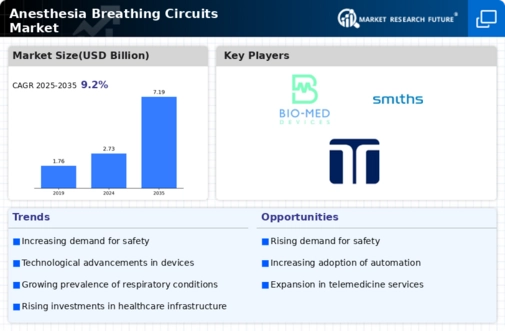Market Analysis
In-depth Analysis of Anesthesia Breathing Circuits Market Industry Landscape
Among the factors that drive the dynamics of Anesthesia Breathing Circuits market are a multiplicity of elements which shape its growth and trajectory. The importance of anesthesia breathing circuits in anesthesia administration is that they help in delivering gases to patients during surgical procedures. This market has key drivers, challenges, trends, and opportunities depicted therein.
One of them is the growth in surgical procedures worldwide. With increasing demand for surgeries comes need for reliable and efficient anesthesia delivery systems. During surgeries these devices contribute significantly to patient safety and comfort resulting in their adoption in healthcare settings. Additionally, technological advancements have led to the development of innovative and user-friendly breathing circuits thereby expanding the entire market.
However, there are challenges facing this market. Manufacturers who would want to introduce new products or upgrade existing ones face stringent regulatory requirements and standards for medical devices. It is important to comply with these regulations so as to ensure that anesthesia breathing circuits are safe and effective; therefore, manufacturers must comply with them. Equally important is the fact that technologically advanced circuits cost more hence their uptake may be slow especially in developing economies with budget constraints.
An important trend emerging within the Anesthesia Breathing Circuits market is increased preference for disposable circuits over reusable ones. In healthcare facilities disposable circuit have gained popularity due to their ability to minimize cross contaminations risks and infections among users. This shift towards disposables has been driven by increased emphasis on infection control measures and patient safety. Manufactures have taken advantage of this movement by offering a variety of disposable anesthetic breathing circuitry.
Moreover, we can see strategic collaboration as well as partnerships among primary companies being witnessed by the market in reference. Such collaborations aim at combining technological know-how and market reach to enhance innovation and give the involved companies a competitive advantage. Joint ventures, mergers and acquisitions are some of the common strategies used to gain an edge over competitors as well as grow market shares.
The global anesthesia breathing circuits market is growing across different regions with North America and Europe leading in growth. The well-developed healthcare infrastructures, rising surgical procedures and strong emphasis on patient safety contribute to the popularity these areas command. Meanwhile, Asia Pacific is showing promising growth prospects as it expands its healthcare infrastructure, performs more surgeries each year and doctors become more aware of superior medical technologies available on the market.







Leave a Comment